Every summer, cyclists from around the world converge on France for the world’s largest sporting event: the Tour de France. During the three-week race, 198 riders travel a course that stretches 3,519 kilometers (2,187 miles) across a mix of flat, hilly, and mountainous terrain. Displaying this type of athletic prowess and endurance is no small feat – and the energy produced by riders is staggering.
To celebrate the Tour de France (and delight every science lover in the country), we’ve crunched the numbers to see just how much power cyclists produce as they pedal. During the Tour de France, participants travel a cumulative 432,947 miles. According to our calculations, their energy output is enough to light up the Eiffel Tower, fuel a Tesla for miles, or cook enough food to feed an army. Knowledge is power – so keep reading for the intriguing (and sometimes shocking) details.
Illuminating the Eiffel Tower
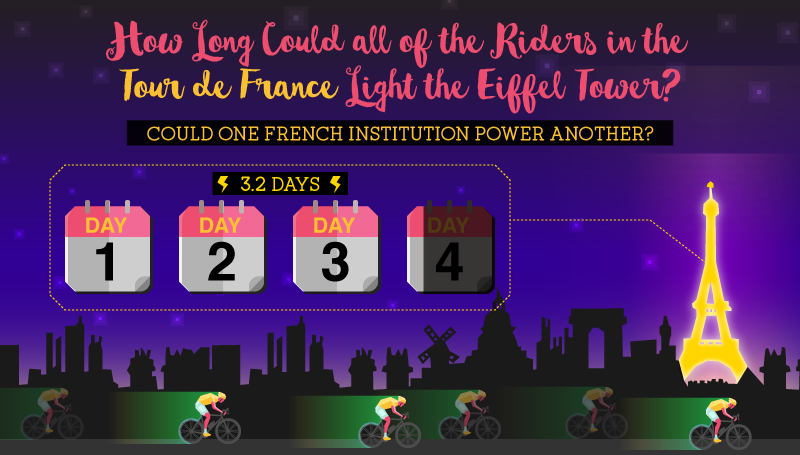
Since the Eiffel Tower’s construction in 1889, nearly 250 million visitors have come from all over the world to gaze upon its majesty. In the evening especially, the sparkling tower is a sight to behold. To illuminate the night, the Eiffel Tower utilizes 20,000 light bulbs, each requiring 6 watts of energy. Every Tour de France rider could light up Paris’s energy-efficient showpiece for almost half a week.
Lighting Up Familiar Buildings
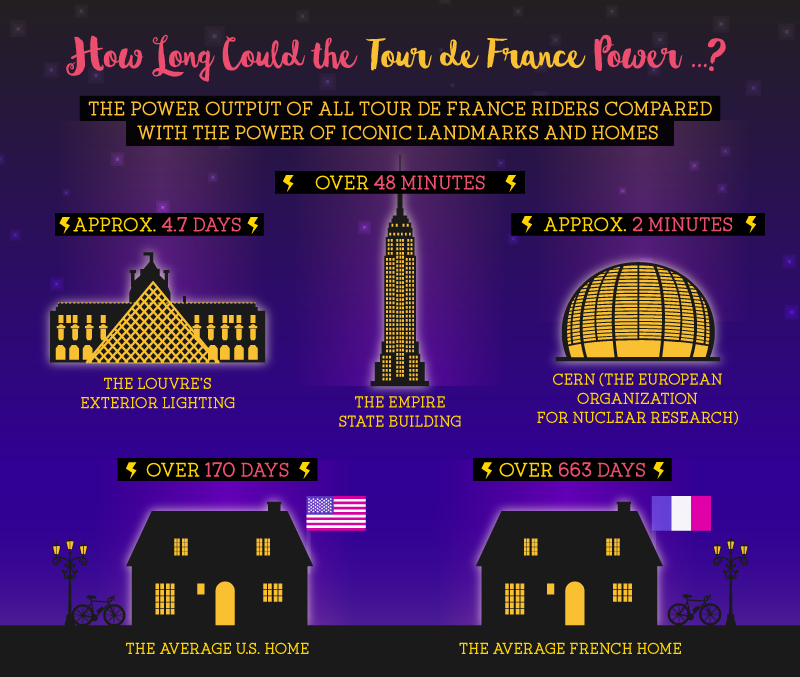
The Eiffel Tower’s not the only light show in town. Home to famous artwork from the Mona Lisa to the Venus de Milo, the Louvre Museum in Paris is the most visited museum on the planet. If it were possible to harness the collective energy generated by all Tour de France participants, riders could illuminate the Louvre’s exterior LED lights for just under five days.
On the other side of the pond, participants could power the 1,454-foot-tall Empire State Building (whose LED system can produce 16 million colors) for just under 50 minutes. The largest energy consumer we looked at, CERN (the European Organization for Nuclear Research) could run for just two minutes on cyclist-generated power. As for residential buildings, the race could power the average American house for around 5.5 months – and the average French house for almost two years (energy efficiency is a priority in France.)
Powering Your Daily Routine
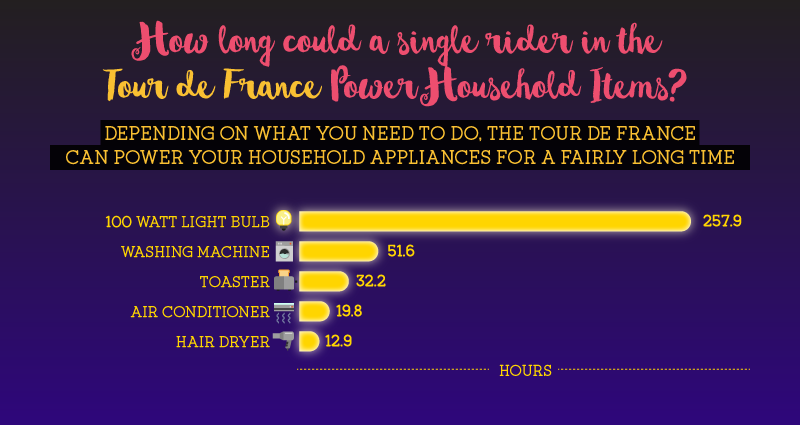
When you wake up and turn on the light, consider this illuminating fact: a single Tour de France cyclist could keep that bulb bright for nearly 258 hours. Ready for breakfast? There’s enough rider-generated energy to make toast continuously for 32 hours. You could also throw in load after load of laundry (for nearly 52 hours), cool your home for approximately 20 hours, and dry your hair for almost 13 hours. Now that’s what we call productivity!
Energy for iPhones, TVs, and DVRs
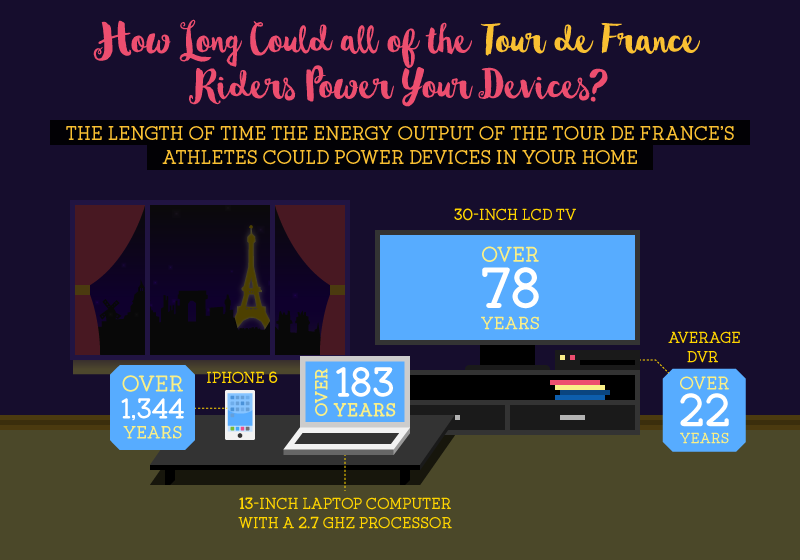
For many of us, cellphones and TVs seem even more important than washing machines and toasters. For all Tour de France participants, traversing the 3,519-kilometer course would generate enough energy to fuel numerous devices. How long could it keep your iPhone charged? A cool 1,344 years. Your laptop could run for more than 183 years, your TV set for over 78 years, and your DVR for more than 22 years. Decades and decades of productivity and entertainment – just from around 400 legs pedaling bicycles.
Powering Tweets, Searches, Emails, and Videos
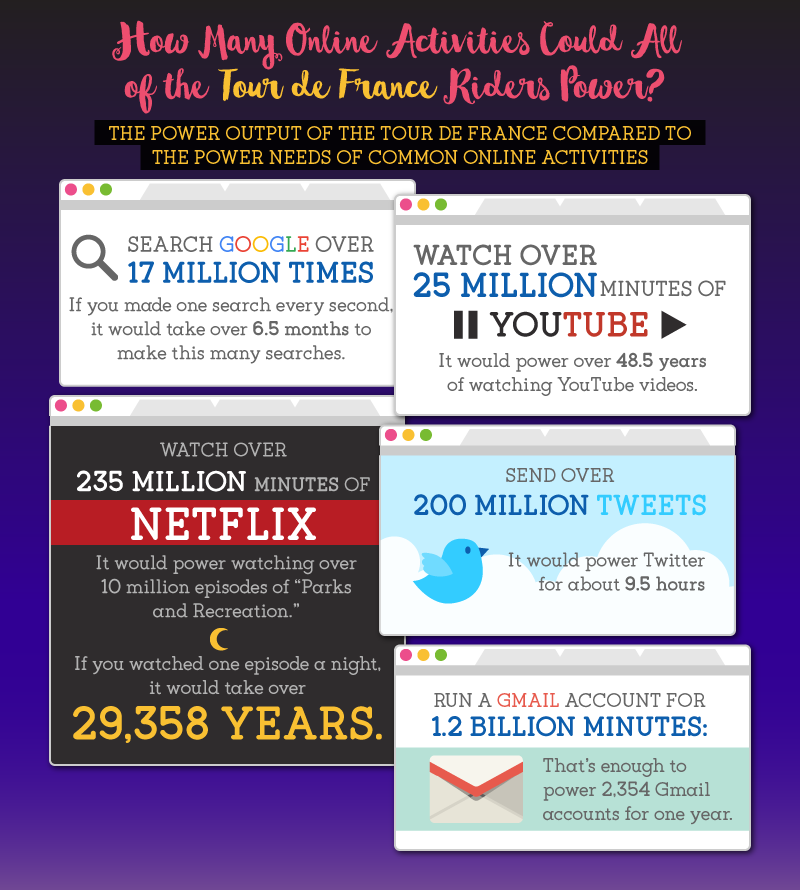
A look at home electronics use wouldn’t be complete without considering people’s typical daily online activities. Energy from all of the Tour de France riders could power Twitter for about 9.5 hours, fuel over 17 million Google searches, or provide 1.2 billion minutes of Gmail use. For people who love the small screen, the energy expended by racers could power 48.5 years’ worth of YouTube videos and 235 million minutes of Netflix. (Better start popping that popcorn.)
Energy to Feed a Crowd
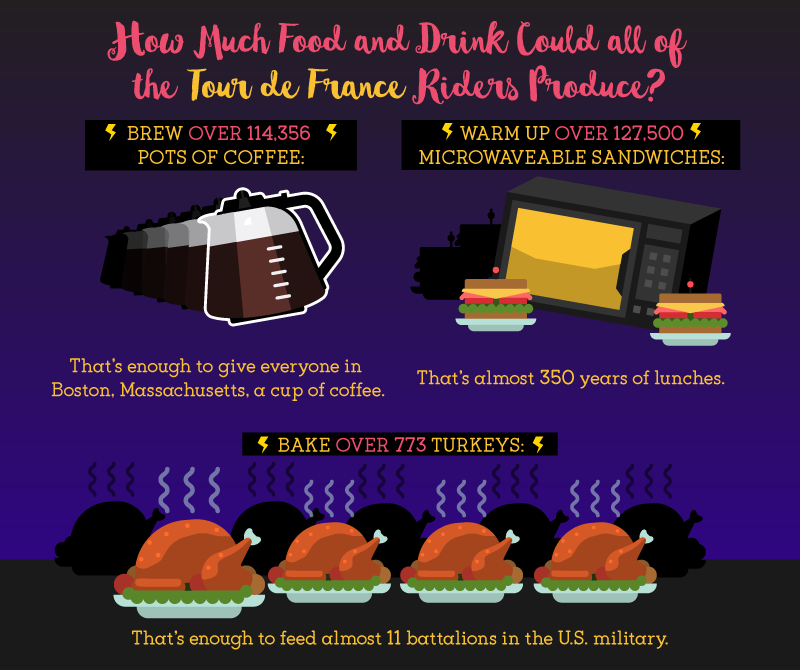
If all that tweeting, emailing, and TV binge-watching has made you hungry, here’s some food for thought: All Tour de France riders produce enough energy to roast 773 turkeys or heat up 127,500 microwaveable sandwiches. Getting sleepy after that big meal? Riders generate enough energy to brew over 114,356 pots of java – enough to keep you going for a while.
Fueling Long Road Trips
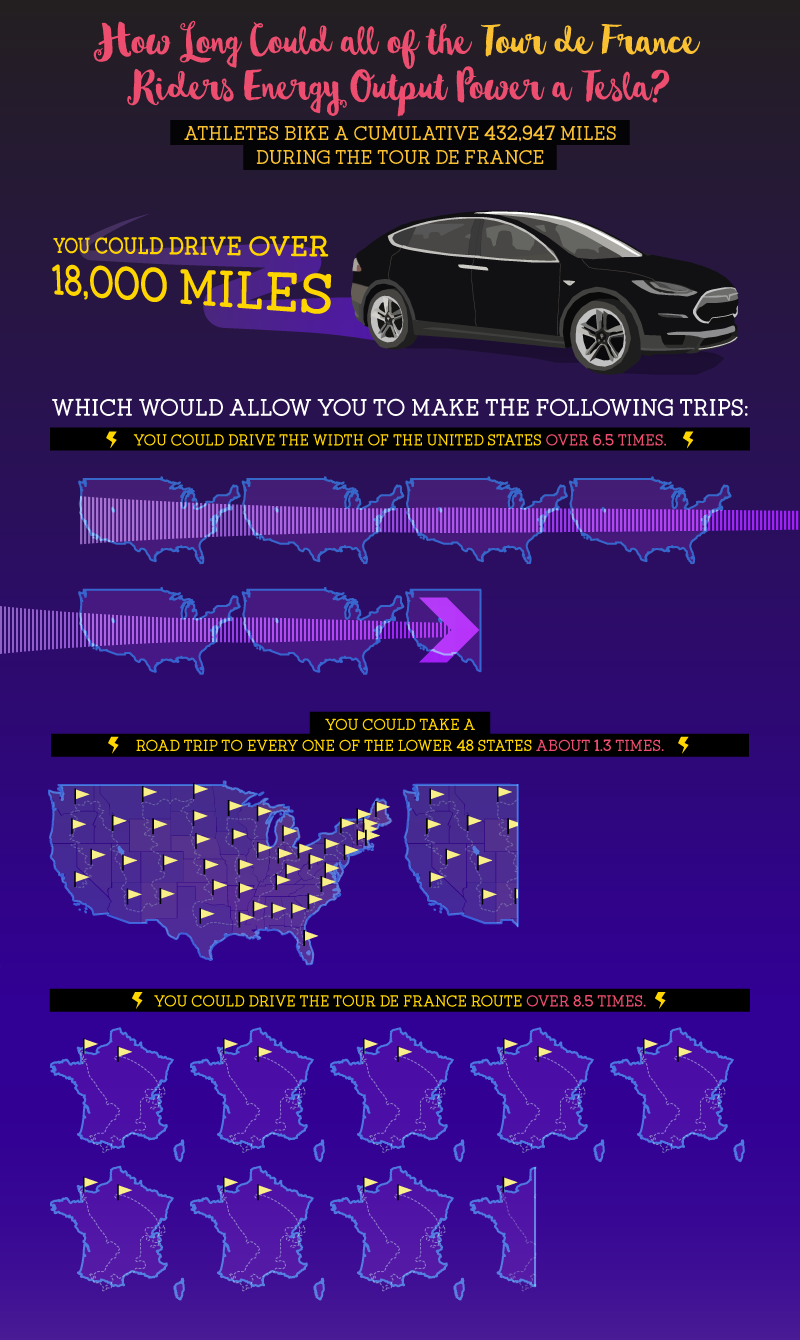
Bicycles aren’t the only energy-efficient way to travel. Fueled by energy generated by all Tour de France cyclists, Teslas could zip across the United States more than 6.5 times. If you craved the ultimate road trip, you could visit every state in the lower 48 states 1.3 times. And should you get really adventurous, you could navigate your Tesla through the entire Tour de France route more than 8.5 times.
Cyclist Power vs. Other Energy
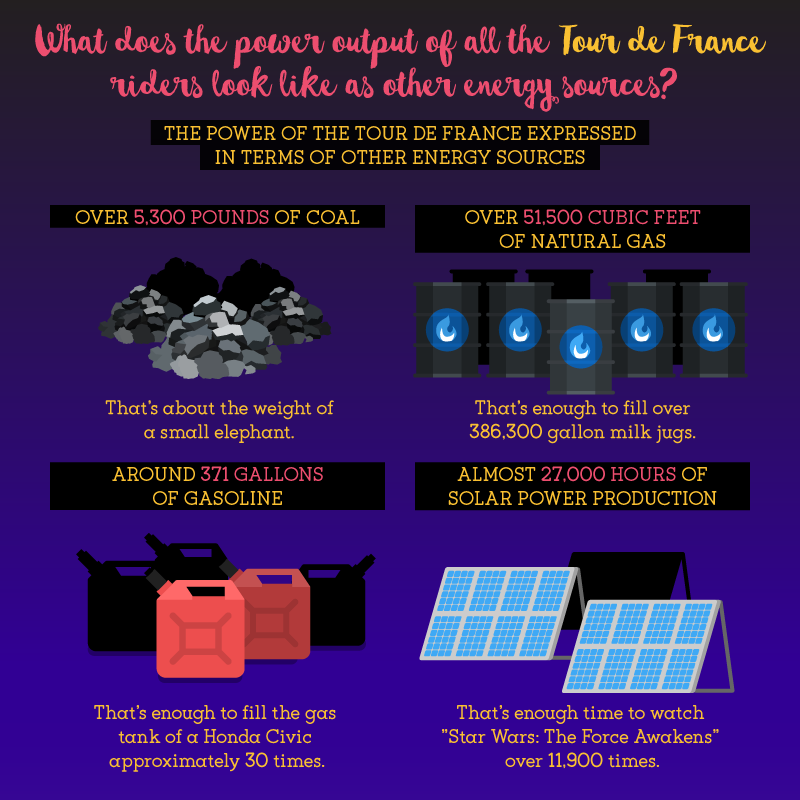
Finally, to visualize the staggering energy output of Tour de France riders, we compared their production with other physical types of fuel. The power of 198 cyclists traveling around 2,200 miles is comparable to the energy output of over 5,300 pounds of coal, 371 gallons of gasoline, 51,500 cubic feet of natural gas, and almost 27,000 hours of solar power production.
As you cheer on your favorite participants in this year’s Tour de France, you can keep these powerful facts in mind. The cyclists you see pedaling furiously are producing enough energy to fuel everything from your electronic devices to your kitchen appliances, from famous landmarks to long-distance road trips. Want to have even more fun? Take a bike ride across town, or jump on your exercise bike while you consider just what you could power with all that pedaling.
Methodology
We calculated the power output of the Tour de France using MET scores, average finish time, and the average weight of Tour de France competitors. This calculation rendered the total number of calories burned per rider.
Using data from the National Institute of Health, we found the actual number of calories converted to muscle energy. From there, we changed calories to kilowatt-hours. This yielded the equivalent electrical output of a single rider. This figure was multiplied by 198, which is the number of riders who have competed in the Tour de France each year for the past five years.
Fair Use
You are encouraged to share the images on this page with your readers. We ask that you link to this page so that your readers have access to our original research.

